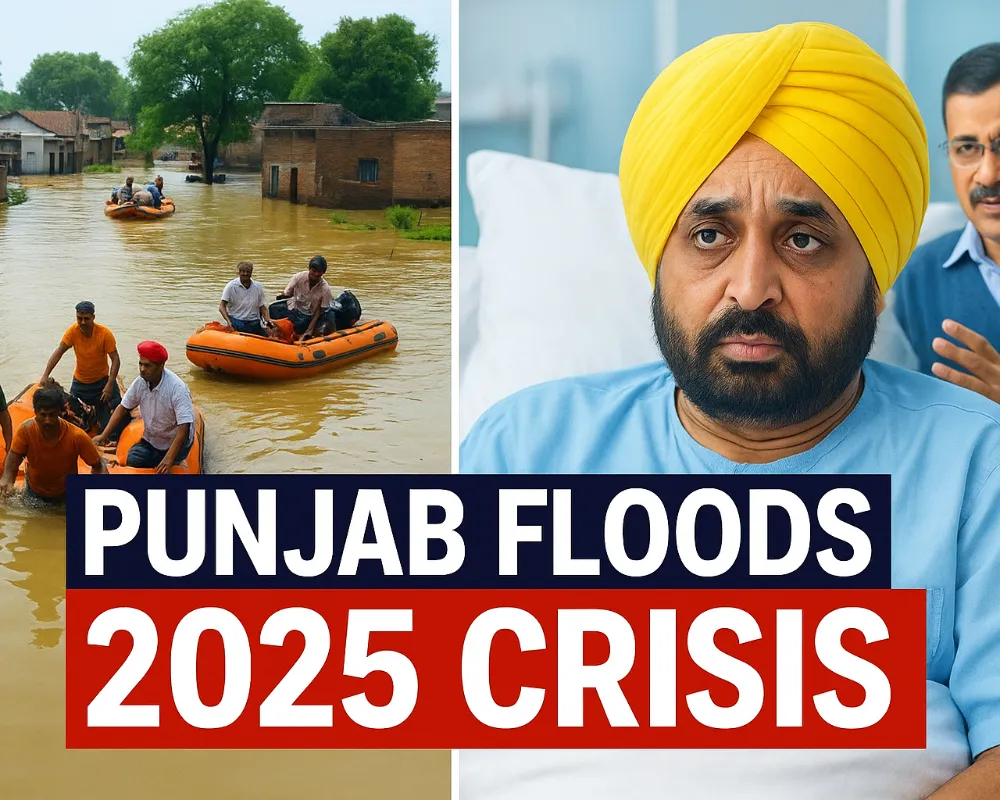Punjab floods 2025 leave 1,900+ villages submerged. With CM Mann hospitalized, Kejriwal oversees relief amid worst floods since 1988.
 Brajesh Mishra
Brajesh Mishra

The Punjab floods 2025 have triggered one of the worst crises the state has faced since 1988. Torrential rains and overflowing rivers have left over 1,900 villages submerged, with at least 43 confirmed deaths. Reports suggest crop damage running into hundreds of crores, raising fears of long-term economic losses for farmers.
All 23 districts are affected, with Central Punjab floods hitting Ludhiana, Patiala, and Jalandhar the hardest. Waterlogging in towns and highways has disrupted both transport and supply chains, making relief efforts difficult.
The floods coincide with a governance challenge: Chief Minister Bhagwant Mann is hospitalized due to illness. His absence has led to growing questions about decision-making during the emergency.
Delhi CM Arvind Kejriwal has stepped in, coordinating with officials on CM Punjab flood relief measures. Critics argue that the lack of visible state leadership is slowing down the response, while others express sympathy for Mann’s condition.
Authorities have set up over 300 relief camps, housing thousands displaced from low-lying areas. Key measures include:
Still, locals report delays in aid delivery. Many have turned to social media and local networks to raise SOS calls, with Punjab water flood news trending widely.
The floods have caused extensive crop destruction, especially of paddy and cotton. Initial estimates put the losses at several thousand hectares under water. Experts warn that compensation and rehabilitation will be critical, with farmers already facing debt pressures.
Heavy monsoon rainfall combined with the Bhakra Dam nearing danger mark intensified the floods. Experts point to physical causes of flooding in Punjab, including:
Authorities issued a Punjab flood warning earlier this week, but many argue that early evacuation was insufficient.
The dual crisis—floods of Punjab and the CM’s hospitalization—has shaped media and political discourse. Opposition parties accuse the government of being unprepared, while many citizens balance criticism with empathy for the CM.
Public frustration is evident on the ground, but there is also resilience: gurdwaras, local NGOs, and community groups have mobilized rapidly to shelter and feed those affected.
The Punjab floods 2025 highlight both environmental vulnerability and governance gaps. Beyond immediate relief, Punjab will need long-term flood management strategies—stronger embankments, early warning systems, and sustainable land use planning.
As waters slowly recede, the focus will shift from immediate rescue to rebuilding livelihoods. Whether the state can emerge stronger will depend on both political will and public solidarity.






Sign up for the Daily newsletter to get your biggest stories, handpicked for you each day.
 Trending Now! in last 24hrs
Trending Now! in last 24hrs